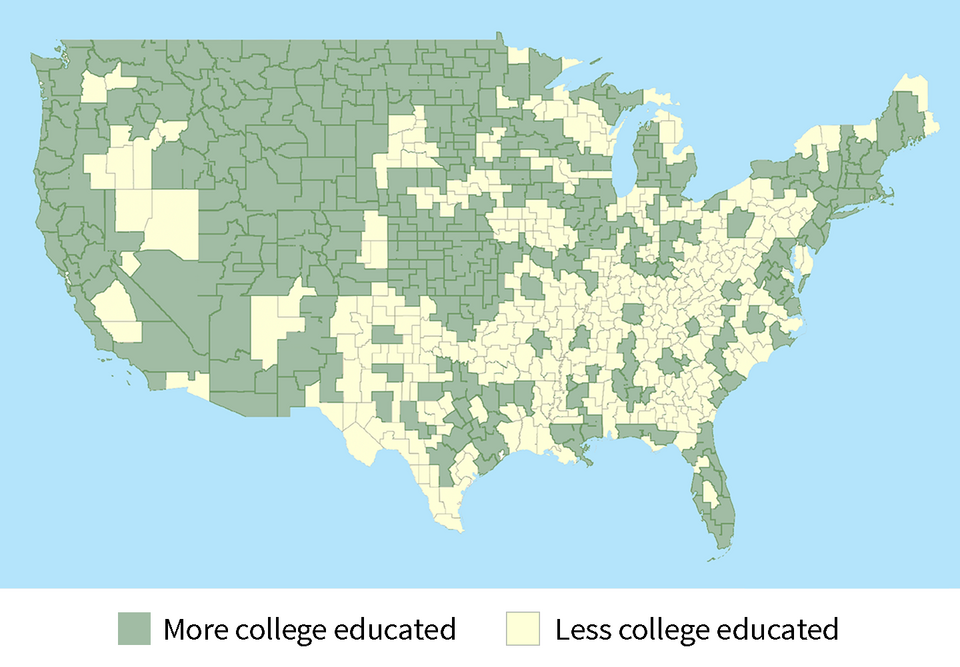Did the “China Shock” Cause Widespread Job Losses in the U.S.?
Did the “China Shock” Cause Widespread Job Losses in the U.S.? [ 4 min read ]
Insights
- Increasing import competition from China between 1990 and 2014 impacted local labor markets differently.
- The China shock did not cause net negative effects on aggregate U.S. employment.
- The China shock instead catalyzed a geographic reallocation of economic activity from areas with lower levels of education to areas with higher levels of education.
- Varying geographic effects of the China shock may have contributed to growing regional inequality and political polarization in the U.S.
An exponential rise in Chinese imports to the U.S. over the past 25 years is often credited with widespread job losses, especially in U.S. manufacturing. This belief motivates the rhetoric around the U.S.-China trade war, often serving as fuel for anti-China discourse in the U.S. Yet, a more fine-grained analysis of how the “China shock” impacted employment, economic activity, and firm behavior in the U.S. is difficult to find. This research attempts to rectify the gap.
The data. Using the U.S. Census Bureau’s Longitudinal Business Database (LBD) as its primary source, researchers examined the impact of China’s import shock on employment, firm activities, and industry affiliation for more than 5 million firms and 7 million establishments in the U.S. The LBD data was supplemented with tax records and survey responses to the U.S. Economic Census, which enabled researchers to track changes in business operations within firms, sectors, and local labor markets between 1990 and 2014.
No evidence of net U.S.job losses resulting from China shock. Increasing import competition from China reallocated jobs and earnings from manufacturing in the U.S. heartland to the service sector in coastal urban areas. Researchers do not find evidence of net job loss, however, in the U.S. as a whole between 1990 and 2014. One-third of manufacturing job losses were caused by existing businesses that repurposed their operations from manufacturing to services, particularly in research, management, and wholesale.Large multinational firms were the primary drivers of manufacturing job losses, switching into research, design, management, wholesale, and other service sectors. Plants operating in the metal, machinery, computers, and electronics sectors, in particular, reallocated U.S. jobs away from manufacturing to non-manufacturing sectors.
China shock effect on service sector. Increased import competition from China had a significant positive effect on U.S. service sector jobs in areas with a higher college-educated population (i.e., greater share of the population with a college degree in 1990 prior to the China shock, compared to the median). On the West Coast and New England, for example, manufacturing job losses were limited, offset by gains in service employment.
China shock effect on manufacturing sector. In areas with a lower college-educated population, on the other hand, the China shock had a significant negative effect on U.S. manufacturing jobs. In much of the South and the Midwest, for instance, manufacturing saw heavy job losses, primarily driven by business downsizing and closures.

Significant reorganization of economic activity and acceleration of regional inequality. Contrary to prevailing views, current analysis finds no support for net negative effects on aggregate U.S. employment from the China shock. Instead, a geographic reallocation of economic activity took place across the U.S., potentially accelerating regional inequality.
U.S. map shows higher versus lower college-educated population per local labor

This research indicates that a structural shift created by the China shock produced winners and losers across the U.S. local labor markets based on initial levels of human capital in the region. Current analysis also suggests that unequal geographic effects of firm adaptation may be an important factor behind growing regional inequality and political polarization in the U.S.
